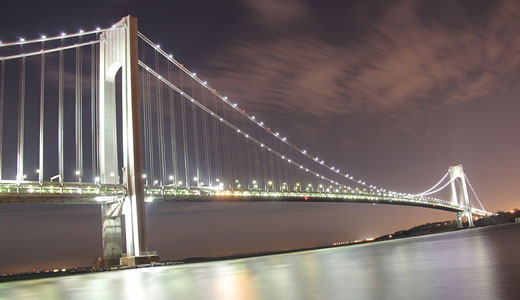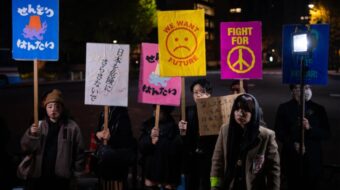
NEW YORK – Pardon the expression, but here we go again. Another local transit agency is repairing another big well-known U.S. bridge using Chinese steel, and thus not U.S. steel or steelworkers. There are a few differences, though.
This time, it’s the Verrazano-Narrows Bridge in New York, not the San Francisco-Oakland Bay Bridge. This time, the agency paying the tab is New York’s Metropolitan Transportation Authority (MTA), not the San Francisco area’s Metropolitan Transportation Commission. And this time, two U.S. senators, including an influential one from New York, joined the Steel Workers union’s protests against the Chinese steel.
There’s another big difference – so far – between the two projects, which neither the senators nor the union mentioned. But we’ll save it for the end of the story.
The New York uproar started last month when the MTA awarded a $235 million contract to the Tutor Perini Corp. to replace the 43-year-old Verrazano Bridge’s upper deck with steel plate. Tutor Perini, in turn, hired two Chinese firms for the actual work. China Railway Shanhaiguan Bridge Group will use 15,000 tons of steel plate fabricated by Angang Steel, another Chinese firm, to replace the bridge’s concrete upper roadway.
The MTA said it did not need to follow the Buy America Act, which mandates use of U.S.-made products on U.S. taxpayer-funded projects, because drivers’ tolls, not tax revenues, will support the bonds to pay for the Verrazano Bridge deck replacement. The Steel Workers and Sens. Charles Schumer, D-N.Y., and Sherrod Brown, D-Ohio, objected, strongly.
U.S. workers engineered and produced the Verrazano Narrows bridge, like 65,000 other major bridges in the U.S., union Vice President Tom Conway told pro-worker radio talk show host Leslie Marshall. Conway questioned why the MTA would let the bridge steel fabrication jobs be exported to China, given high U.S. unemploy-ment, and Chinese subsidization of its steel firms.
“America’s working families, who pay taxes and tolls with their labor, can do the job. We’re not anti-trade. Trade has been the foundation of our country since its inception. But exploiting labor – the fact you can get away with it in an oppressive governmental scheme that is essentially a dictatorship – shouldn’t be a comparative advantage,” Conway said.
Schumer and Brown hit the unfair trade angle in their letter to the MTA. They said sending the Verrazano Bridge’s steel fabrication jobs to China would rob them from Nucor Steel in upstate New York. Nucor has the qualified workforce and milling capacity to handle the Verrazano repairs. The senators said supply jobs would go, too.
“Angang is…a state-owned enterprise, which means they are wholly owned by the Chinese government and as a result receive significant preferential treatment,” the senators wrote MTA Chairman Thomas Prendergast. As a result, firms such as Angang “can dramatically drive down costs on steel production. The Chinese government, through its state-owned steel market, has a long history of subsidizing production and dumping products into the United States at a reduced cost in order to threaten the solvency of our domestic market,” leading to “dozens” of U.S. government steel trade anti-dumping orders against the Chinese.
Chinese subsidies and China’s undervalued currency, the yuan, “give all imports from China a significant competitive advantage against competitors worldwide… Chinese state-owned steel companies will continue to have a significant competitive advantage against American and other foreign steel manufacturers,” they stated.
“If government entities such as the MTA cannot make the conscious choice to source from domestic producers” or from non-Chinese allies who follow global trade rules, “The global steel market will be forced into a race to the bottom due to the unfair mercantilist practices of the Chinese government,” Schumer and Brown warned.
The senators and the union were too polite to mention another potential differ-ence between the Verrazano and Bay Bridge projects: Some 32 Chinese-made 17-foot road-supporting steel anchor rods, installed in the Bay Bridge’s new East Span, cracked.
The Chinese rods fractured after workers installed them on the Bay Bridge. The rods were supposed to flex so the bridge could stand another earthquake. The 1989 Loma Prieta quake heavily damaged the bridge. Replacing cracked Chinese rods was one reason replacing the Bay Bridge cost over $6 billion, six times the original estimate.
Planners considered only one type of bolt for those road anchor rods, and no protective coating, a state report on the Bay Bridge’s problems later concluded. That’s why the rods cracked, it said. But in 2004, when state officials first started discussing overhauling the Depression-era Bay Bridge, the National Steel Bridge Alliance warned against using Chinese steel – even before the Steel Workers raised the alarm.
“Rather than using a value engineering process to optimize the design and decrease costs, it was decided to use a China-based fabricator and Chinese-produced steel. It could be redesigned more economically with a U.S.-based collaborative effort. It now appears the result of rejecting that option will be increased costs and substantial delays,” NSBA said after the Chinese-made Bay Bridge rods cracked.
Photo: Verrazano-Narrows Bridge. Wikipedia (CC)










